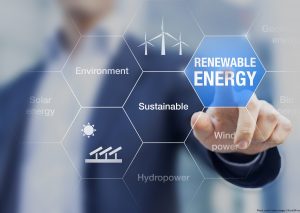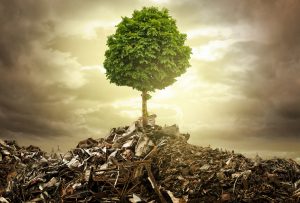by LaurenL | Sep 30, 2016
 Using renewable energy is a hot topic in the waste management industry, but it’s one that many people know less about than they think. Sure, we all recognize the most common renewable energy sources, like solar power and wind energy. But, there are many other types of renewable energy that aren’t quite as common knowledge. Did you know that sewage waste is now being used to heat and cool buildings? Or, that wasted food is used to generate electricity? Our waste has increasingly become a valuable way to replace non-renewable energy sources. Here are a few surprising examples:
Using renewable energy is a hot topic in the waste management industry, but it’s one that many people know less about than they think. Sure, we all recognize the most common renewable energy sources, like solar power and wind energy. But, there are many other types of renewable energy that aren’t quite as common knowledge. Did you know that sewage waste is now being used to heat and cool buildings? Or, that wasted food is used to generate electricity? Our waste has increasingly become a valuable way to replace non-renewable energy sources. Here are a few surprising examples:
1. Biomass
Biomass, organic materials like scrap lumber, forest debris, crops, and manure, can be used as fuel to create electricity or other forms of power. This type of waste, which generally comes from demolition, construction, or farming practices, can be burned to create heat. In biomass power plants, this heat is harnessed and used to heat industries and homes, or it is used to produce steam. The steam from burning biomass fuel is used to run turbines to make electricity.
2. Sewage
There is a near constant stream of warm sewage that comes from the biomatter, dishwashers, showers, and industrial processes that produce hot water and send it down the drain. Researchers in China have found ways to capture this heat and use it to regulate temperature inside buildings. In Philadelphia, this technology has been installed at the Southeast Wastewater Treatment Plant. Using only sewage and wastewater, a 20,000 square foot compressor building at the plant is fully heated and cooled by the system.
3. Landfill Gas
The life cycle of your garbage doesn’t end when it’s dumped at the landfill. Instead, once there, the decomposition of solid waste begins to produce a byproduct that can be used in surprising ways. Methane gas, a by-product of garbage decomposition, is collected at landfills and used as thermal energy, to generate electricity, or to do both at the same time. Landfill gas is also being used as an alternative to fossil fuels like natural gas.
4. Waste Heat
Major data centers, like IBM’s Zurich Research Laboratory, use water to cool down its servers. Once the water has done its job, these centers are left with hot water that is often treated as waste heat. Now, instead of disposing of this waste, it is being used to heat nearby homes. Much like hot sewage is used to warm buildings, other forms of waste heat, like that produced when cooling machinery, can be used to generate alternative heating and cooling systems.
5. Food Waste
Heartland Biogas Project in northern Colorado is just one example of an organization that is finding ways to use food waste to create energy. They, like many others, collect millions of gallons of food waste and combine it with anaerobic digesters. These digesters are bacteria that break down the waste. In the process, they give off methane. This methane is a powerful gas used to generate electricity and other forms of renewable energy.
How KenBay Can Help You Manage Your Waste
Whether or not your business produces waste that can be used as a renewable energy source, we know waste management can be a burden. Because trash compactors will reduce the weight and size of your waste, they are a great way to cut down your waste removal costs and improve the efficiency of waste management.
Trash compactors like KenBay’s RotoPac are ideal for industrial settings, and allow companies to reduce the volume of their trash at a ratio of six to one. The RotoPac can handle all kinds of waste from food to recyclables, and even solid hazardous waste.
Don’t let something like a waste get in the way of your business operations. If you’re interested in trash compactors or finding a committed consultant to help you reduce your waste, call KenBay. We can tell you more about our services, no matter what industry you’re in, or how much waste you are creating!
Photo credit: Getty Images / NicoElNino
by LaurenL | Sep 16, 2016
 So, you throw away your garbage, it’s picked up by a waste management company, and then it’s delivered to a landfill where it sits to rot into eternity, right? Wrong. Allow us to introduce you to landfill gas. The life cycle of your garbage doesn’t end when it’s dumped at the landfill. Instead, once there, the decomposition of solid waste begins to produce methane gas. What’s methane gas? A colorless, odorless, gas that is all around you. It’s also a by-product of garbage decomposition. And, it can be put to use in surprising ways.
So, you throw away your garbage, it’s picked up by a waste management company, and then it’s delivered to a landfill where it sits to rot into eternity, right? Wrong. Allow us to introduce you to landfill gas. The life cycle of your garbage doesn’t end when it’s dumped at the landfill. Instead, once there, the decomposition of solid waste begins to produce methane gas. What’s methane gas? A colorless, odorless, gas that is all around you. It’s also a by-product of garbage decomposition. And, it can be put to use in surprising ways.
Why is this important? Because, according to the United States Environmental Protection Agency (EPA), “[c]onverting LFG to energy offsets the need for non-renewable resources such as coal and oil, and reduces emissions of air pollutants that contribute to local smog and acid rain.” And, that’s something we can all appreciate.
How Landfill Gas is Used
Methane, also known as landfill gas, can be captured in landfills and converted into a useable energy source. Instead of vanishing into the air, a system of wells, blowers, or vacuums collect landfill gas and take it to a processing facility. Depending on the facility the landfill gas is delivered to, it will be put to use in different ways. Here are a few of them:
1. Electricity Generation
In the United States, most captured landfill gas (about 75%) is used to generate electricity. The landfill gas to electricity process starts deep inside the pile of waste. To collect the gas, a vacuum-like blower captures it from the center of the garbage heap. After that, the gas is transported through a pipework system from the garbage heap to a processing facility, where it is transformed into electrical energy. Typically, the electricity created at landfills is used on-site, but it is also sold to the grid for general use.
2. Direct Use as Thermal Energy
Landfill gas is also used to offset, or replace, the use of other types of fuel. Instead of natural gas, coal, or fuel oil, landfill gas can be used as thermal energy. This fuel is utilized in boilers, dryers, kilns, greenhouses, and other machines that rely on thermal energy. Landfill gas can be used to fire pottery and glass, heat water for aquaculture (fish farming), and warm greenhouses. Other industries that currently use landfill gas include auto manufacturing, chemical production, food processing, pharmaceuticals, cement and brick manufacturing, wastewater treatment, consumer electronics and products, paper and steel production, and prisons and hospitals.
3. Cogeneration
Not only is landfill gas used to generate electricity or thermal energy, sometimes it is used to produce both! Because this process generates two types of energy at once, it is aptly called cogeneration. In this process, landfill gas is used in engines and turbines to produce both heat and power, typically in the form of hot water or steam.
4. Alternative Fuels
Using landfill gas as an alternative fuel is one of the newest ways it is being put to use. Because landfill gas is produced all-day, every day, and will continue to be produced for as long as we have decomposing garbage, it is often viewed as a renewable energy source to be used in place of fossil fuels. Just one example, landfill gas can be used as the equivalent of natural gas, a nonrenewable energy source that will one day run out.
How KenBay Can Help You Manage Your Waste
Whether your business has made the switch to zero waste, or it contributes to the production of landfill gas, we know waste management can be a burden. Because trash compactors will reduce the weight and size of your waste, they are a great way to cut down your waste removal costs and improve the efficiency of waste management.
Trash compactors like KenBay’s RotoPac are ideal for industrial settings, and allow companies to reduce the volume of their trash at a ratio of six to one. The RotoPac can handle all kinds of waste from food to recyclables, and even solid hazardous waste.
Don’t let something like a waste get in the way of your business operations. If you’re interested in trash compactors or finding a committed consultant to help you reduce your waste, call KenBay. We can tell you more about our services, no matter what industry you’re in, or how much waste you are creating!
by charlotte | Aug 6, 2016
 The waste to energy debate in the United States has been a tense one as environmentalists and politicians weigh many aspects of a solution that hasn’t yet caught on. With municipal landfills getting zoned off in most major cities nationwide, there is certainly a need for new waste management streams, and we have a moral obligation to stop sending it to third world countries whose infrastructures can’t handle it. Though a zero landfill initiative would be a dream come true for the government and environmentalists alike, there isn’t hope of this becoming a reality anytime soon, necessitating accessible alternatives like an investment in more waste to energy plants.
The waste to energy debate in the United States has been a tense one as environmentalists and politicians weigh many aspects of a solution that hasn’t yet caught on. With municipal landfills getting zoned off in most major cities nationwide, there is certainly a need for new waste management streams, and we have a moral obligation to stop sending it to third world countries whose infrastructures can’t handle it. Though a zero landfill initiative would be a dream come true for the government and environmentalists alike, there isn’t hope of this becoming a reality anytime soon, necessitating accessible alternatives like an investment in more waste to energy plants.
What is the Waste to Energy Debate?
Waste to Energy, or WtE, is a means of disposing of waste, usually by incineration, to produce electricity and heat, and even biofuels. There are less than 100 WtE plants in the United States, while in Europe it has become much more popular and is accepted there as a form of renewable energy. American environmentalists would argue that it can’t be renewable if it depends on human waste. Many WtE plants can sell energy or heat directly to the grid, while the combustible fuel producers create methane, methanol, ethanol or synthetic fuels that can be used for transportation as well as in industry. Aside from the debate as to whether waste to energy is actually a renewable energy stream, many people use the Not-in-my-Backyard (NIMBY) argument against building more WtE plants because they are worried about smells, smoke, and other pollutants. These concerns have been largely disproven through research, however.
The Cost of Transportation
There is the question of the cost associated with shipping waste to WtE plants and whether it’s worth the transportation costs. The fact is that many municipalities are already increasing their waste transportation costs because of full landfills, and are sending their garbage not only to other states but to other countries. The rising costs of shipping waste are significant and becoming the norm in more densely population centers around the country.
Is it Worth Shipping to a Waste to Energy Plant?
It may seem an unnecessary cost to ship to a WtE plant right now, but the more mainstream this solution becomes, the more plants will be built. By fronting the cost now, you are investing in the future of waste management in this country. The hope is that someday you will have a municipal waste to energy plant that won’t require excessive shipping costs. There are numerous ways to reduce the amount of waste you are producing, as well as the option of investing in a commercial trash compactor. Both scenarios will help offset some of the costs of shipping your waste to a WtE.
If you are considering whether to do more with your waste then send it to your local landfill, the waste to energy solution is a great opportunity for you. If you want to speak with waste management experts to discuss your options, give KenBay a call!
 Using renewable energy is a hot topic in the waste management industry, but it’s one that many people know less about than they think. Sure, we all recognize the most common renewable energy sources, like solar power and wind energy. But, there are many other types of renewable energy that aren’t quite as common knowledge. Did you know that sewage waste is now being used to heat and cool buildings? Or, that wasted food is used to generate electricity? Our waste has increasingly become a valuable way to replace non-renewable energy sources. Here are a few surprising examples:
Using renewable energy is a hot topic in the waste management industry, but it’s one that many people know less about than they think. Sure, we all recognize the most common renewable energy sources, like solar power and wind energy. But, there are many other types of renewable energy that aren’t quite as common knowledge. Did you know that sewage waste is now being used to heat and cool buildings? Or, that wasted food is used to generate electricity? Our waste has increasingly become a valuable way to replace non-renewable energy sources. Here are a few surprising examples: 

 So, you throw away your garbage, it’s picked up by a waste management company, and then it’s delivered to a landfill where it sits to rot into eternity, right? Wrong. Allow us to introduce you to landfill gas. The life cycle of your garbage doesn’t end when it’s dumped at the landfill. Instead, once there, the decomposition of solid waste begins to produce methane gas.
So, you throw away your garbage, it’s picked up by a waste management company, and then it’s delivered to a landfill where it sits to rot into eternity, right? Wrong. Allow us to introduce you to landfill gas. The life cycle of your garbage doesn’t end when it’s dumped at the landfill. Instead, once there, the decomposition of solid waste begins to produce methane gas.  The
The 